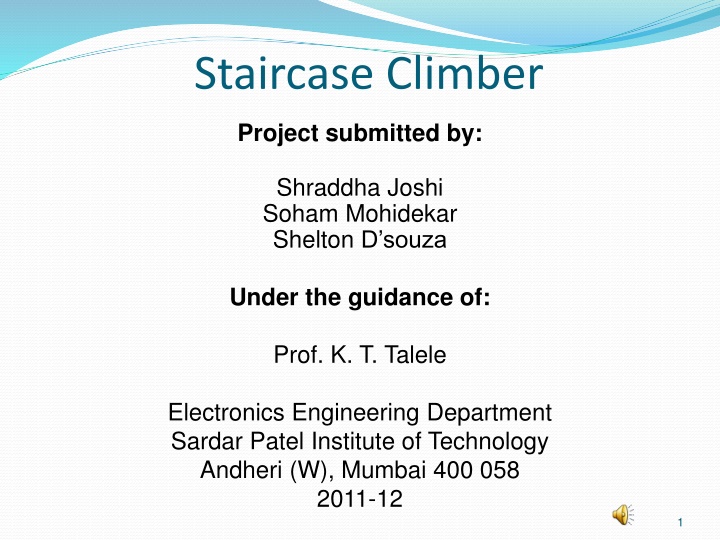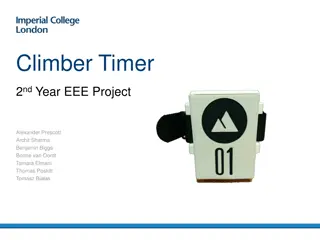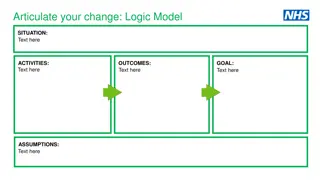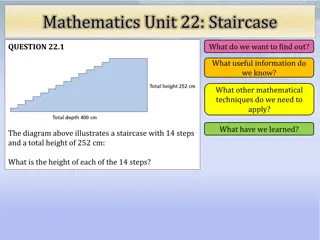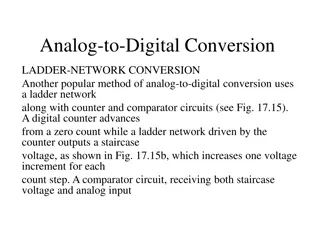Innovative Staircase Climber Project for Assisting Elderly and Physically Challenged Individuals
This project showcases a staircase climber machine designed to help elderly and physically challenged individuals navigate stairs effortlessly. The machine features automatic seat adjustment based on the staircase slope, powered by components like ATMEGA 8535 microcontroller, servomotor, and accelerometer. With a detailed concept, block diagram, component descriptions, and application areas, this project stands out for its practicality and innovation in the field.
Download Presentation

Please find below an Image/Link to download the presentation.
The content on the website is provided AS IS for your information and personal use only. It may not be sold, licensed, or shared on other websites without obtaining consent from the author.If you encounter any issues during the download, it is possible that the publisher has removed the file from their server.
You are allowed to download the files provided on this website for personal or commercial use, subject to the condition that they are used lawfully. All files are the property of their respective owners.
The content on the website is provided AS IS for your information and personal use only. It may not be sold, licensed, or shared on other websites without obtaining consent from the author.
E N D
Presentation Transcript
Staircase Climber Project submitted by: Shraddha Joshi Soham Mohidekar Shelton D souza Under the guidance of: Prof. K. T. Talele Electronics Engineering Department Sardar Patel Institute of Technology Andheri (W), Mumbai 400 058 2011-12 1
Organization of the presentation 1. Concept 2. Block diagram 3. Description of various components used in the project 4. Description of our prototype 5. How our machine is different from others used in the same field 6. Application areas of the machine 7. References 2
Concept Machine helpful for carrying a aged or physically challenged person up and down the staircase. Seat adjusted automatically according to slope of the staircase. Completely automatic. Project, a prototype of an actual staircase climber 3
Seat Servomotor adjustment Block Diagram Power source ATMEGA 8535 Motors Path tracking and obstacle detection Accelerometer 4
ATMEGA 8535 8 bit RISC microcontroller 8-bit Timer/Counters Has four PWM channels Conversion of analog to digital values. 5
Accelerometer MMA 7361 accelerometer which is a analog accelerometer Can sense movements on 3 axes, that is X, Y and Z Output for 0 to 90 degree tilt on X axis is from 1.5 volts to 2.5 volts 7
Servo motor High torque of 16 kg/cm and powered by 6 V battery OCR values of 15 to 35 corresponds to ON time pulse width of 1-2 ms Shaft of the motor attached to the seat 9
3.5 rpm motors Skid steering mechanism with four 3.5 rpm motors, two on each side Motors driven by a relay circuit Rotation of motors is as per the tracked path 12
Relay circuit Four relays for driving the four 3.5 rpm motors SL 100 npn transistor used as the switching element Inputs to the relay circuit come from the Microcontroller 13
Obstacle detector Infrared obstacle detector Can sense obstacles within a range of 60 cms Output of obstacle detector goes to the microcontroller 14
Path tracking circuit Consists of three IR transmitter -receiver pairs (TCRT 5000) Comparator LM-341 used Output of each of the IR pairs goes to one of the terminals of the comparator 15
Path tracking logic Whenever the sensor detects the white line it gives a low output. 000-invalid state 001- Move right (left pair of wheels will be activated) 010- Move straight (both pair of wheels will go forward) 011- Move right (left pair of wheels will be activated) 100- Move left (right pair of wheels will be activated) 101-invalid state 110- Move left (right pair of wheels will be activated) 111- Move straight (both pair of wheels will go forward) 16
Prototype Seat Optical sensor Relay Circuit ATMEGA 8535 3.5 RPM motors 25
How is the machine different from others used in the same field Automatic and comfortable seat adjustment irrespective of the slope of staircase. Automatic movement of vehicle Path tracking facility is provided (useful in industries) Obstacle detection 27
No risk factor Person to push the wheelchair is not required 28
Applications Buildings which do not have elevators. Industries. Railway Bridges. Places which are at high altitudes (Pilgrim places) 29
References Design and Implementation of Stair-Climbing Robot for Rescue Applications-Basil Hamed, International Journal of Computer and Electrical Engineering, Vol. 3, No. 3, June 2011 Climbing and descending Vehicle- U.S. Patent document,4790548,12/1988 Autonomous Stair Climbing for Tracked Vehicles, DOI: 10.1177/0278364907080423, Anastasios I. Mourikis, Nikolas Trawny, Stergios I. Roumeliotis, Daniel M. Helmick and Larry Matthies, The International Journal of Robotics Research 2007; 26; 737 Introduction to Autonomous Mobile Robots, Roland Siegwart and Illah R. Nourbakhsh http://pagesperso-orange.fr/topchair 30
